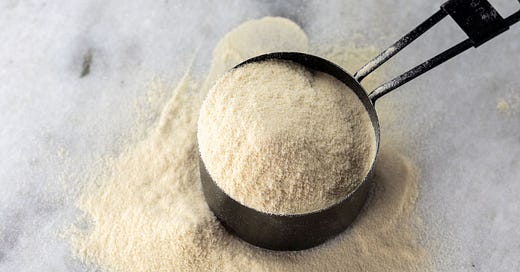Flour by Jordan Mackay
Don’t be naïve: An addictive powdery white substance makes the world go round. It makes you happy from the inside out, and even though it’s probably not that good for you, you want to consume it all the time. We’re not even talking about sugar. Nope, it’s flour that produces magically airy, flavorful bread and silky, toothsome pasta. In the skilled hands of Italian grandmothers (and other talented cooks), flour is a miracle.
Even if you don’t bake much, a stale bag of flour probably resides in your pantry. But, depending on your cooking goals, you’ll want to keep a diverse arsenal of flour on hand, namely All-Purpose, bread flour, semolina, and 00 (“zero-zero”). These flour types - all made from wheat - are related but ultimately need a little untangling - some work best as pasta, while others as bread. To understand, it’s helpful to think of two main types of flour in Italian cooking: hard and soft.
Durum and semolina fall into the former camp and excel at pasta. The hardest type of wheat, durum, seems evolutionarily designed for shaped pasta (think orecchiette), extruded (think rigatoni), and traditional flat noodles. Semolina, with its signature golden hue, is the endosperm (the kernel) of durum wheat, separated via milling. Semolina possesses a uniquely challenging, glass-like consistency that causes it to shatter into tiny crystals when milled, as opposed to becoming a soft powder like regular flour. Your fingers will feel a sand-like texture when you run them through it.
Pasta’s unique consistency owes itself to the relationship between protein, starch, and water. Both semolina and durum produce excellent pasta, as their ‘hardness’ makes them less receptive to water than soft (regular) flour, keeping their doughs firm with a heavenly crunch. Semolina integrates even more poorly with water than durum flour and is usually used for dried and extruded pasta. The more water the dough absorbs in dried pasta, the more must be removed - a time-consuming and costly process. Plus, semolina’s toughness provides that addictive al dente crunch.
Regular flour is made from softer wheat varieties than durum and is often used for fresh pasta with silky tenderness as the goal. However, fresh pasta almost always incorporates eggs, which provide the protein that coats the flour’s starch, protecting it from getting too saturated with water (while adding richness and color). Without eggs, the dough ends up soft, gummy, and dumpling-like. Some cooks prefer All-Purpose flour for fresh pasta, while others recommend bread flour. You should play with both or mix them‚ to find what fresh pasta dough you prefer. You can even add durum or semolina.
The term 00 refers not to the type of wheat nor the protein content but to the degree to which it’s milled - the finest degree. For this reason, it’s the go-to flour for the exceptionally silky pasta of Italy’s northern regions. Combined with eggs, it can be rolled thinly to make the most delicate sheets or strands. Of course, 00 is also famously used in Neapolitan pizza dough, as its fine grain makes for a smooth but elastic dough with a crust that somehow melds tenderness, elasticity, and crunch. Fine 00 flour absorbs water more efficiently than coarser-grained flour, meaning you need less water to make the dough and, therefore, less evaporates as the crust crisps in the super-hot Neapolitan ovens.
All-purpose flour, despite its slightly larger grain than 00, is a versatile option. It's perfectly good for pizza and pasta, although its texture may feel a bit coarser and its bubbly structure a bit less emphatic. As the name implies, All-Purpose flour is good for a range of doughs, giving you the freedom to experiment. It’s also the go-to for breading for the fryer, as stronger flours might carry too much water and get soggy during frying.
Bread flour has a higher protein percentage than All-Purpose, making dough stretchier and chewier. If you desire such a texture, it works well as pizza dough and, of course, for bread and focaccia. You’ll not get the shatteringly crisp, airy architecture of 00 flour, but many styles of pizza don’t call for that.
So, this is just your initiation into the addictive world of white powder. Don’t be afraid to play around with these types of flour to find your perfect mix. Then move on to other kinds of flour, as there is a vast world of them out there: whole wheat, chestnut, rye, buckwheat, and spelt, to name a few. The first bag’s on us. You’ll be back.



